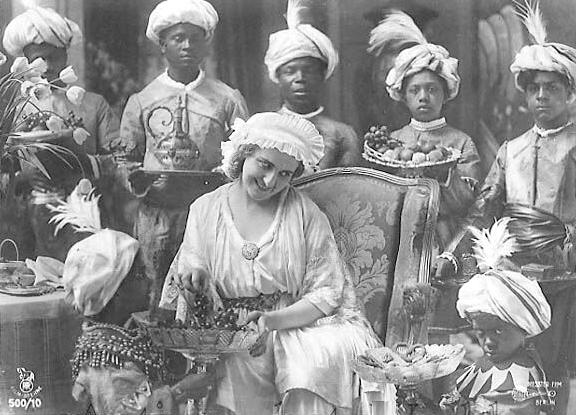
German Movie Industry: World War I (1914-18)

Figure 1.--'Die Prinzessin von Neutralien' was a romantic commedy made in 1917. The title is a bit of a mystery, it does not seem to have any relation with the War and importance of neutrality. It stared the popular Henny Porten. The film was also known as 'Ihr Hoheit, die Dollarprinzessin'. Notice how the American currency 'dollar' was used. The Kaiser and German General Staff until 1918 saw the Americans as businessmen without any significant military capability. The British from the beginning of the War took a very different view.
|
|
The Germans earlier than the British realized how effectively movies could be in mobilizing domestic support for the War effort. What the Germans did not fully understand was the importance of the United States and the possible use of films to influence American public opinion. The German film industry was not as large as the British or French industries, let alone that of the United States. The German industry, however, grew explosively during the War. This ws in part because it was difficult to obtain foreign films because of the Allied naval blockade. Even films from neutral America were difficult to obtain. This created opportunities for the German film industry which began to expand, laying the ground work for the vibrant film industry of the post-war period. The German Government made no effort to distribute feature films in the United States. The Government banned most foreign film (1916). The industry at the time had been importing some foreign films from Denmark which was neurtral. As the War progressed, the German military gradually seized control of the country and evetually made economic policy. Chief of Staff of the Germany Army, General Ludendorff, believed that movies had a military potential by influencing public opinion. He used the new Universum Film Aktiengesellschaft studio (UFA) to shoot films promoting the War. His focus was, however, on domestic opinion. Not until a massive American army appeared on the Western Front did he and other German officisls fully appreciate how important America would be in the War. Te Navy has asured the Geneal Staff that the U-boats would prevent any American army from crossing the Atlantic. The Germans were not entirely inactive. The Army organized a secret film campaign in the United States. The American Correspondent Film Company was established. Photographer Albert K. Dawson was attached to the German and Austrian Armies. Dawson destinguished himself as one of the most vimportant film correspondents during the War. His work, however, had no impact on American public opinion which was firmly set early in the War by German axtgions, including the invasion of neutral Belgium, sinking the Lusitania, introduction of poison gas, and British war propaganda. The growth of the German film insutry, however, was explosive. There were 25 studios when the War began (1914), but 139 studios by the end of the War (1918). And they were producing sophisticated feature fims like 'Die Prinzessin von Neutralien' (The Princes of Neutralia, 1917) a popular romantic commedy (figure 1).
HBC

Navigate the Historical Boys' Clothing Web Site:
[Return to the Main German movie page]
[Introduction]
[Activities]
[Biographies]
[Chronology]
[Cloth and textiles]
[Clothing styles]
[Countries]
[Topics]
[Bibliographies]
[Contributions]
[FAQs]
[Glossaries]
[Images]
[Links]
[Registration]
[Tools]
[Boys' Clothing Home]
Created: 5:36 AM 7/22/2017
Last updated: 5:36 AM 7/22/2017



